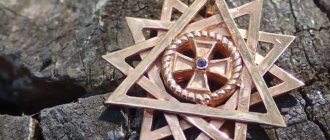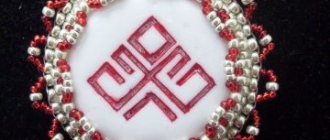In astrology, it is believed that Venus patronizes representatives of the zodiac signs Taurus and Libra. Women born under these signs have a special magnetism and attractiveness to men.
To develop such qualities in yourself and improve your personal life, you can ask for the protection of the goddess Venus.
In ancient times, appealing to the gods was carried out through targeted sacrifices; now there is a simpler way - wearing signs related to a specific deity.
Thus, the Venus talisman (or the mirror of Venus) is dedicated to the goddess of love. Bearers of such an amulet note positive changes in well-being and in relationships with the opposite sex.
Myths about Venus
The most famous incarnation of this planet is the goddess whom the Greeks called Aphrodite and the Romans called Venus. In Greek mythology, there are two versions of the birth of Aphrodite. According to the first, she was born from the seed and blood of Uranus, castrated by Kronos, which fell into the sea and formed snow-white foam (hence her nickname Anadyomene, which means “foam-born”). Aphrodite emerged from the sea foam on a shell (an ancient symbol of the female womb), and reached the nearest island. Ancient authors call this island a small island in the Aegean Sea - Kythera or Cyprus.
According to another version, set forth by Homer, Aphrodite was the daughter of Zeus and the goddess of rain, and possibly the earth, Dione. The name Aphrodite itself may be derived from the Greek word aphros, which means “foam.”
Aphrodite's counterpart in ancient Rome was the goddess Venus, whose name was related to the Latin noun venus, which meant "sexual love" and "sexual desire." For the Romans, Venus was a symbol of birth and fertility, love and sexual desire. The Romans believed that their legendary ancestor Aeneas was born from the union of Venus and the Trojan shepherd Anchises. The constant epithets of Venus in Rome were “merciful” and “purifying.”
Aphrodite-Venus was one of the most popular goddesses of antiquity and therefore many myths were associated with her. As a rule, they tell about her love affairs with gods and mortals. Venus's husband was the god of blacksmithing, Hephaestus, known to the Romans as Vulcan.
One day, the sun god Helios witnessed her infidelity and reported it to her husband. Hephaestus was angry and forged a thin invisible net, which he attached to the lovers' bed. The next time they gave themselves to each other, she entangled them, not giving them the opportunity to move. So Hephaestus captured them at the very moment of Venus’s betrayal. He called on the other gods to witness this shameful spectacle. At the same time, Hermes exclaimed: “If only I could lie here next to the golden Aphrodite!” Subsequently, Hermes' dream came true. They had a bisexual son, Hermaphrodite.
In antiquity, two forms of Aphrodite-Venus were distinguished: Heavenly Venus (lat. Venus Coelestis) and Earthly Venus (lat. Venus Vulgaris). This idea was first formulated by Plato in his dialogue on the nature of love, The Symposium. Celestial Venus symbolized love, which was aroused by thoughts of the eternal and divine, Earthly Venus represented the beauty created in the material world, as well as the principle of procreation of the human race.
The goddess of love, Venus, personifies the main Divine law - the Law of Unity, and the unifying force of this law is love. The first conciliar letter of the Apostle John says,
God is love, and he who abides in love abides in God, and God in him [1].
The founder of Stoicism, Zeno of Citium (c. 336–264 BC), also interpreted Aphrodite as “the force that properly connects the separate parts of something with each other” [2].
From connections with gods and mortals, Venus had numerous offspring, the members of which varied greatly in character and occupation. One of the most famous children from Mars Venus was the god of love Eros (lat. Cupid or Cupid), her constant companion and assistant, personifying the love attraction that ensures the continuation of life on Earth.
Who needs a talisman?
There are certain situations when a symbol can radically influence fate. For anyone whose horoscope is dominated by Venus, it is simply a must.
You should wear the amulet in the following cases:
- Suitable for couples who have been in a love affair for a long time . We all have moments when feelings subside and need to be rekindled. The amulet will help to attract the attention of your partner and renew your former passion and romance.
- Will help lonely people attract love into their lives . First of all, it will fill the heart of the person himself with love, harmony and happiness.
- Helps in separation from a loved one and preserves feelings . After all, being at a distance can both quickly forget your feelings and, conversely, fall in love even more.
- Promotes the transition of relationships into a new direction: creating a family and having children .
Attention! The amulet will help if a person resorts to it with pure intentions and sincere desires.
Venus in Kabbalah
In Hebrew, Venus is called Noga (נוגה), which means “outer splendor”, as well as “vessel of light”, “abode of radiance”. It corresponds to the letter Dalet (ד). The name of the letter is related to the word “דלת” (“door”). This image has a dual meaning, the door divides and connects. An open door symbolizes potential and the future. Dalet is the Door to the House of God, where those who have renounced their personal “I” and are ready to dissolve in God go. The door is a symbol of the Christian Mother of God, which in the Akathist (Orthodox hymn) is called the “Door of Salvation” [3]. The word ״דלד״ “dalut” (“beggar”), which is also usually associated with this letter, also indicates complete self-denial.
According to Kabbalistic teaching, the planet Venus corresponds to the Sephira Netzach, whose name means “Victory” or “Fortitude” [4]. This is the last sephira of the Pillar of Mercy, which lies at its foundation. Victory in the Sephira Netzach is the Victory of the Forces of Unity. Netzach is the sephira of Divine beauty, inner perfection. It represents the emotions and instinctive impulses of people, as well as the feelings that unite them. The divine name Netzach - יהוה צבאות - Yahweh Tsebaoth [5] (“Lord of Hosts”).
Features of a love talisman
In ancient times, girls donated various gifts to the goddess Venus so that she would not deprive them of female happiness. Great importance was attached to the Gods. Times have changed, but even today the amulet named after the goddess is considered very powerful and effective .
The Venus talisman makes women more charming, gentle and sensual. In a word, it gives ladies all the qualities to attract their soulmate. It also protects against envy, intrigue, gossip and disease . This talisman is not a love spell, and it is impossible to force someone to love.
Venus in astrology
In classical astrology, Venus belongs to the trine of the Earth and corresponds to the element of Earth, and on the Kabbalistic Tree of Life, the Venus sephira Netzach has a fiery nature. Thus, we can conclude that Love, which Venus personifies, embraces and connects all four elements of our world.
Symbol of Venus.
In astrology, Venus patronizes the arts, is prone to libations and loves various aromas, while she prefers luxury, idleness and sensual pleasures. The abodes of Venus are Taurus (the nocturnal abode) and Libra (the daytime abode), the sign of her exaltation is Pisces, and in exile Venus is in Aries and Scorpio.
Ank.
Venus is considered one of the most favorable planets. As Ibn Ezra wrote, “she is a good planet, correcting the soul striving [for copulation] and promoting fertility and reproduction” [6].
The astrological symbol of Venus - ϙ, is a stylized image of her mirror. The circle is located above the cross, which should personify the presence of a certain “spiritual attraction” that pulls the cross upward into the elevated areas belonging to the circle. The cross, consisting of four parts (four elements), subject to the laws of generation, decay and death, will certainly find its redemption if it is raised within this great circle of spirituality. One possible interpretation of this symbol is the Egyptian hieroglyph ankh, meaning the key of life.
How does the Venus talisman work?
Venus is traditionally associated with pleasure, fertility and prosperity. In this regard, the following properties are attributed to the Venus amulet:
- attracting male attention;
- increased sensuality;
- eliminating metabolic problems;
- improvement of health, and, as a result, appearance;
- finding a partner or even a spouse;
- for family carriers - bringing novelty to the relationship with her husband.
You may be interested in: The meaning of the Slavic amulet Hammer of Svarog
In addition to improvement in the love sphere, the Venus talisman is able to awaken the energy of creativity in a woman, as well as strengthen intuition, as a result of which the bearer will be able to avoid all sorts of dangers arising from intrigue, envy, the evil eye and damage.
IMPORTANT! The Venus amulet must be worn in direct contact with the skin and closer to the heart. By the way, it is believed that when the goal is achieved (the wearer has found her love, got married, relations with her spouse have been harmonized), the talisman must be removed and buried.
Planet Venus in astronomy
Venus is the second planet farthest from the Sun in the Solar System, along with Mercury, Earth and Mars, belonging to the family of terrestrial planets.
Due to a number of characteristics - for example, mass and size - Venus is considered the “sister” of the Earth. Pentagram of Ancient Sumer
Venus is the hottest planet in the solar system: its average surface temperature is 735 K (462 ° C), even though Mercury is closer to the Sun, so the Kabbalists were right in relating it to the element of fire. Venus is covered by an opaque layer of highly reflective sulfuric acid clouds, which, among other things, obscures the planet's surface from direct visibility.
Venus is the third brightest object in our sky after the Sun and Moon.
The planet reaches an apparent magnitude of −4.6m, so it is bright enough to cast shadows at night. As a rule, at night it can be seen not far from the Moon. Venus is rarely visible to the naked eye during daylight hours. This is the first planet for which movement across the sky was recorded at the beginning of the second millennium BC, and its trajectory resembles a five-petal rose or a five-rayed star; according to some versions, it was the trajectory of Venus that formed the basis for the sacralization of the pentagram symbol. This trajectory was called the “Venus Pentagram”. The “Pentagram of Venus” is the trajectory that the planet Venus takes when observed from Earth.
It is interesting that among different peoples this brightest star in the sky was associated precisely with the goddess of love. In pre-Semitic times, it was simply called ˈastar - star, from this word comes the name of the Akkadian goddess of love and war Ishtar. In late Babylonian texts it, together with the Moon and the Sun, forms a triad. According to some assumptions, Babylonian astronomers knew that during its period of great brightness after or before the inferior conjunction, Venus appears to be a crescent. According to this version, Babylonian astronomers paid so much attention to Venus precisely because of this feature, since this feature made it the sister of the Moon. So don’t be surprised if you find a crescent moon in some images of Astarte, Ishtar or Venus. The first observations of Venus using an optical telescope were made by Galileo Galilei in 1610. Galileo discovered that Venus changes phases. This proved that it shines with the reflected light of the Sun (about which there was no clarity in the astronomy of the previous period), which means that it is not a star.
Due to its trajectory, Venus is visible in the sky twice, in the evening and in the morning. According to Cicero, the ancient Greeks called the morning star Phosphorus (Ancient Greek Φωσφόρος - “bringer of light”) when it rose before the Sun, and Eosphorus (Ancient Greek ἑωσφόρος - “bringer”) when it rose after it. They also called the evening one Hesperus (ancient Greek Ἓσπερος; Evening). In ancient times they were considered different planets. When it was established that the Evening and Morning stars are the same luminary (according to Pliny, this discovery belonged to Pythagoras, according to other sources - Parmenides), Phosphorus was identified with Hesperus.
Creation and activation of the Venus amulet
If you still don’t want to buy a talisman, you can make it from paper, cardboard, wood, or embroidery. The finished amulet needs to be activated. To do this, it is cleaned and charged. Cleaning a purchased item is carried out by placing it in a vessel with earth for a day. Next, the amulet is placed in the water element for 24 hours. On the third day, the object is calcined with candle fire. The final stage is charging the air with energy.
After these procedures, the amulet will be filled with positive energy and will protect its owner.
Venus Correspondences
Hebrew name
: Leg (נוגה).
Sephira
- Netzach (נצח).
The divine name
is Yahweh Tsebaoth (יהוה צבאות).
Archangel
- Anael (אנאל).
Reason
- Hagiel (הגיאל).
Spirit
- Kedemel (כדמאל).
Olympic Spirit
- Hagit.
Day
- Friday.
Element
- Water (all 4 elements, as well as Spirit).
Qualities
: cold and wet.
gender
.
Green
color The main properties
are beauty, love, emotions, fertility, connection.
Chemical elements
- copper.
Incense
- sandalwood, myrtle, musk, rose scent, all sensual scents.
The main metal of Venus is copper, which turns green when oxidized and aged. In Latin, “copper” is cuprum, and some believe that the name of the island of Cyprus, where, according to legend, Venus-Aphrodite was born, came from this word. Silver is also attributed to Venus due to its white color and the relationship of Venus with the Moon. How about [7].
Venus stones are those gemstones that are green or white-pink in color. These are emerald, green jasper, turquoise, pearls, which, like Venus, were born in the sea, as well as all the beautiful stones of green, white or pink [8].
Plants of Venus have a bright and pleasant aroma - these are rose, saffron, verbena, violet, coriander, as well as anemone [9], evergreen myrtle [10], violets as the first flowers of spring, poppy as a symbol of fertility, all kinds of aphrodisiacs. Venus includes beautiful and graceful trees (for example, cypress), as well as those that bear sweet and tender fruits: pears, oranges, pomegranates. Also considered the fruit of Venus is the apple that Prince Paris gave her, recognizing her as the most beautiful goddess.
The animals of Venus include those that have great sexual potency - dogs, rabbits, goats [11] and bulls. She also owns such beautiful animals as panthers, fallow deer and deer. Sometimes ancient myths include bears and wolves in Venus's retinue to show that the power of love pacifies even dangerous predators. Fish, dolphins and turtles living in the sea can also be associated with Venus [12].
The birds of Venus are considered to be loving doves [13] and sparrows, as well as swans and swallows, heralding spring.
How to clean materials for an amulet
To exclude the influence of extraneous energy on the carrier, all materials selected for the manufacture of a magical item must be subjected to a purification procedure. Materials are purified using all 4 elements: water, fire, air and earth.
You may be interested in: The meaning and legends of the Slavic amulet Overcome the grass
The ritual algorithm is as follows:
- Cleansing by the power of the earth. To do this, you can take the actual soil or sand, but you can also replace it with regular table salt. Earth, sand or salt is poured into a container, after which the selected materials are buried in this substance and left overnight.
- Cleansing with water. The excavated material is placed in a container with water and left for a day.
- Purification by fire. Take 6 candles and hold the material in their flame or above it for several minutes.
- Air purification. Leave materials outdoors during the day.
BY THE WAY! There is also a simplified cleaning option: placing the materials in salt water for a day. After cleaning and manufacturing, the talisman will also need to be charged.
Venus in man
Venus rules the irrational, emotional part of the human mind. It can be associated with the right hemisphere of the brain, with singing and dancing, acting and painting, with everything that cannot be expressed in words.
The powers of Venus are associated with such properties and qualities as ardent love, attraction, beauty, good nature, the desire to grow and spread.
It was love that inspired the creators of many, many great works of painting and literature, sculpture and jewelry. Therefore, Venus is considered the patroness of the arts and creativity.
Love can manifest itself in different ways, and its diversity is reflected in the versatility of Venus. This planet is responsible for creativity, pleasure, sensuality and sexuality. In ancient Greek, different types of love were designated by different words: “agape” (spiritual love), “eros” (carnal love), “storge” (kinship love) and “philia” (friendship).
Friendship is also associated with Venus because it is usually based on attraction of one kind or another (even if not sexual), and maintaining it requires social communication skills - another quality associated with Venus [14].
Venus is also associated with such negative phenomena as lust, jealousy and deception.
How to do it yourself?
Making a Venus amulet yourself is not that difficult.
The main thing in this process is the right time for manufacturing, suitable material and positive energy. It is best to make a talisman on Friday evening (this day helps to charge any talisman with energy). The sunset of the day is chosen because the beginning of romantic and love relationships is correlated with the end of the old (lonely) way of life and the onset of a new one (giving life and bonding the souls of two people).
The most successful month for making an amulet is April (the month of veneration of Venus).
From what materials?
If you do not have the opportunity or desire to purchase a ready-made amulet made of copper or precious stone, then you can make it yourself. There are many options for materials for manufacturing:
- Cardboard. Cut a square or round piece of cardboard (can be any size) and hand draw the Venus symbol on it with red paint. On the back of the paper amulet, write down the name of the patroness and her entire retinue.
- Tree. To make a wooden amulet you will need a wood stencil of the required size and a wood burning machine.
- Stone. You will need a small but smooth pebble on which to draw the sign of the goddess. This amulet can be carried in a wallet or handbag.
- Embroidery. The symbolism of the goddess can be embroidered on clothing, a handkerchief or other piece of fabric, which will always be near the wearer’s body. Embroidery should be done with red thread, which symbolizes a love affair.
What are the appearance features?
Venus talismans come in two types:
- one-sided (the symbolism of the patroness is drawn on it and purification is carried out, the finished amulet must be worn on the body);
- double-sided (this option is suitable for those who are looking for not only symbolism in the amulet, but also a list of Venus’ assistants, her retinue guarding the bearer of the talisman).
Symbols
The symbols of Venus indicate her beauty, attractiveness, eroticism and indestructible strength; this is a mirror, a rose, a lamp, a wedding belt.
One of the most important attributes of Venus is her belt. Homer describes it as follows: Patterned belt: all the charms were contained in it;
It contains love and desires, whispers of love, explanations, flattering speeches that have more than once captured the minds of the intelligent [15].
The Belt of Venus represents the powerful and indestructible force of divine love.
Another important attribute of Venus is the golden arrow. Gold (in ancient texts, Venus usually wears gold jewelry and is called "golden-haired") indicates Venus' connection (the desire for unity) with the Sun (manifested God), whose instrument she is.
Another symbol of Venus is the ankh (cross with an eye). It can be considered as one of the forms of the astrological sign of Venus.
Places associated with Venus include green flowering gardens and parks, baths and beaches.
Agrippa attributed to Venus “dance, loving embraces and laughter, as well as amiable and happy faces” [16]. Arcana "Empress" Tarot of Thoth.
The meaning of a love amulet
The purpose of the Venus talisman is to normalize and maintain love relationships at the highest level. The talisman deprives a girl of the opportunity to carefully analyze relationship options and does not allow her to think about options for their development. This power allows you to make relationships strong and lasting.
Overly eccentric women who start wearing a talisman acquire peace of mind and balance. This allows the lady to concentrate on her family members. Show care, maintain a home and be happy in a family atmosphere.
If the girl is on the path of developing a romantic relationship. But her lover is not nearby, the amulet is able to preserve the relationship even at a distance. It prevents situations from arising that can destroy relationships, but, on the contrary, strengthens them.
In addition to the issue of relationships, the talisman is able to protect its owner from the effects of various diseases, self-interest and bad intentions of the surrounding society.
Magical images
Typically, images of Venus emphasize the femininity and attractiveness of her nature. She is considered the most beautiful of all goddesses, conquering the entire universe with the power of her beauty and therefore is often depicted with long hair, naked, half-naked, or, on the contrary, in luxurious robes.
In the grimoire "Picatrix" Venus is described in the following guises:
The image of Venus, according to the wise Beilus, is a wife standing upright and holding an apple in her right hand.
According to the wise Picatrix, the image of Venus is a wife holding an apple in her right hand, and in her left hand a comb similar to a tablet, on which the following signs are inscribed: OAOIOA.
According to the sage Hermes, the image of Venus is a figure with the body and face of a man, the head of a bird and the legs of an eagle.
Ptolemy believes that the image of Venus is a naked wife with a chain around her neck, by which she is held by the image of Mars standing in front of her.
According to other sages, the image of Venus is a woman with flowing hair, seated on a deer; in her right hand there is an apple, and in her left hand there are flowers, and she is dressed in white [17].
Agrippa describes three images of Venus:
...a woman with the head of a bird and the legs of an eagle, holding an arrow in her hand.
<…> a naked maiden with loose hair, with a mirror in her hand and a chain around her neck, and next to her is a handsome young man holding a chain with his left hand and smoothing the maiden’s hair with his right; and both of them look at each other lovingly, and next to them is a small winged boy with a sword or arrow.
<…> the figure of a girl with flowing hair, in long white clothes, with a laurel branch, an apple or flowers in her right hand and with a comb in her left [18].
The Chariot of Venus is drawn by two doves (sometimes swans or sparrows) and is adorned with the astrological signs of Taurus and Libra. At the feet of Venus sits a small winged boy, armed with a bow and arrows that evoke love; this is her son from the god Ares - Eros. Sometimes, instead of a chariot, Venus travels on a shell, which is carried by tritons. In her hands she can hold a mirror, an arrow, flowers, a burning heart.
Jewelry in the form of an amulet
Copper was a common material for making jewelry in the form of an amulet of Venus. Currently, talismans are made from a variety of precious minerals and metals. But the mineral must correspond to Aphrodite. Under her protection are a number of stones such as: turquoise, jade, emerald, garnet, carnelian, coral, lapis lazuli, green jasper. In most cases, earrings, bracelets and pendants are made from these stones. They can only be used as protection if purchased in a store. Since purchasing from the previous owner can imbue the stone with negative energy.
Pentacles of Venus from the Lesser Key of Solomon
First Pentacle of Venus. (from Mathers' edition) Second Pentacle of Venus. (from Mathers' edition) Third Pentacle of Venus. (from Mathers' edition) Fourth Pentacle of Venus. (from Mathers' edition) Fifth Pentacle of Venus.
(from Mathers' edition) Five of Pentacles dedicated to Venus - Green
.
First Pentacle of Venus.
He, like those who follow, serves to control the Spirits of Venus, and especially those described here.
Note from Mathers.
Secret Signs of Venus and Names of Angels: Nogahiel, Acheliah, Socodiah [or Socohiah] and Nangariel.
Second Pentacle of Venus.
These Pentacles also serve to obtain favor and honor, and for all other things that relate to Venus, and to fulfill all your desires here.
Note from Mathers.
The letters around and inside the Pentagram make up the Names of the Spirits of Venus. The verse is taken from Song of Solomon VIII, 6 “Put me as a seal on your heart, as a ring on your hand: for love is strong as death.”
Third Pentacle of Venus.
It, if shown to any person, will serve to attract love. His Angel Monachiel is to be called on the day and hour of Venus, the first hour or the eighth.
Note from Mathers.
The following names are written within the Figure: IHVH, Adonai, Ruach, Achides, Aegalmiel, Monachiel and Degaliel. Verse from Genesis I, 28 “And God blessed them (Elohim), and God (Elohim) said to them, Be fruitful and multiply, and fill the earth and subdue it.”
Fourth Pentacle of Venus.
He has great power, since he compels the Spirits of Venus to obey, and can force any person you wish to come to you at once.
Note from Mathers.
At the four corners of the Figure are the four letters of the Name IHVH. Other letters make up the Names of the Spirits of Venus: Schii, Eli, Ayib, etc. The verses are taken from Genesis II, 23 "This is bone of my bones and flesh of my flesh" and II, 24 "And the [two] shall become one flesh."
The fifth and final Pentacle of Venus.
Once you show it to someone, it miraculously excites and encourages love.
Note from Mathers.
Around the central Square are the Names Elohim, El Gebil and two other Names which I cannot decipher and have therefore given them as they appear [in the manuscript]. The signs are from Crossing the River. A verse from Psalm XXI: 15 is written around the circle: “My heart became like wax, it melted in the midst of my insides.”











